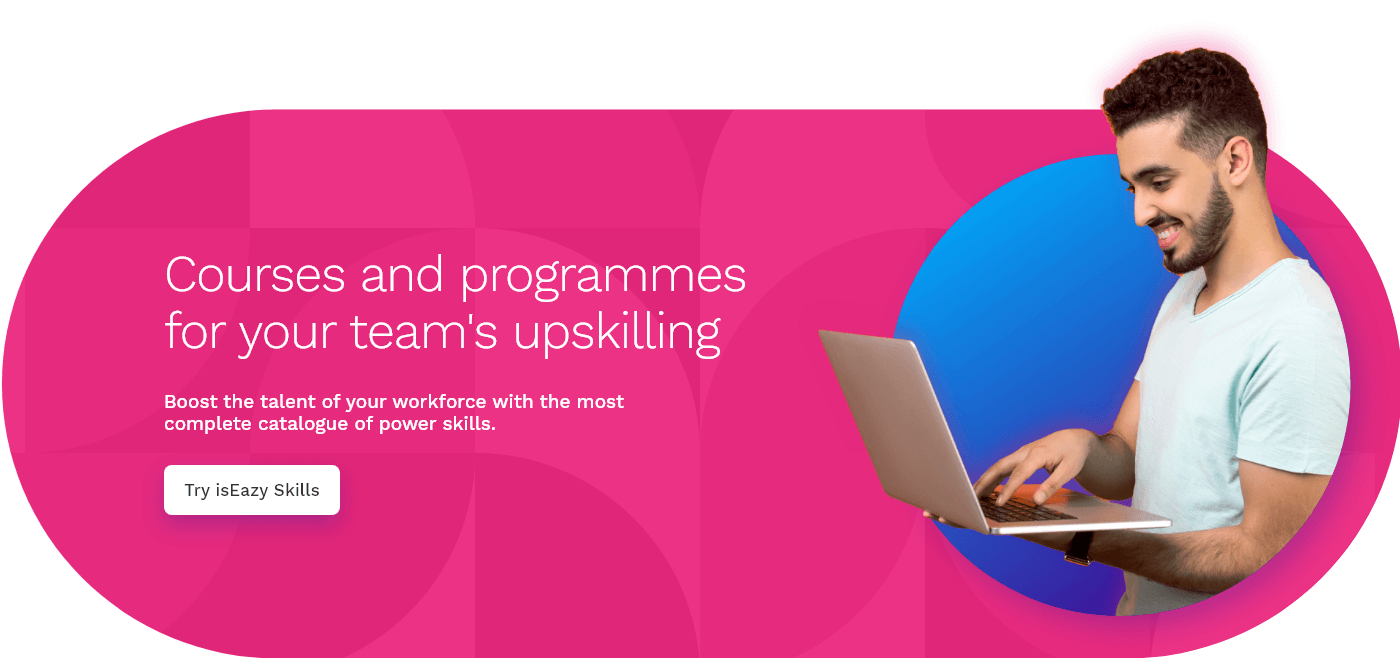Table of contents
ToggleMost of the big challenges companies face today are the result of rapid technological change, widespread globalization, and shifts in market demands. These ongoing changes – which were initially expected to take years to unfold – have accelerated dramatically since the onset of the pandemic, forcing companies to adopt new ways of working and collaborating.
Naturally, adapting to these changes has brought the need to develop new skills. Today, many business leaders agree that the need for these new skills is more pressing than ever. The results of the McKinsey Global Survey identify which of them are the most important, prominently including social and emotional skills such as leadership, empathy and adaptability.
Regardless of which specific skills it focuses on, the implementation of a skills transformation strategy is more important than ever to achieve success. In this blog post, we walk you through how to achieve it, step by step.
What is skills transformation and why is it important for companies?
Skills transformation represents a fundamental shift in how organizations ready themselves and adapt to constantly changing market demands. It is an initiative-driven process that deliberately focuses on the acquisition of new skills and competencies. These skills will allow the company that develops them to be successful in the future, and to close any gaps that could slow their growth.
Dealing with the threat posed by these knowledge gaps is where the true value of skills transformation lies. Many once-important skills are quickly becoming obsolete, while others emerge to take their place, often in response to the demands of emerging industries such as artificial intelligence, cloud computing and data science. Transforming the skills they possess allows companies to adapt to these changes, and stay relevant in an increasingly technological professional world.
On top of these changes is globalization, which has greatly expanded the scope of competition in the labor market, and other advances such as automation and digitalization. These latter have emphasized the need for specific skills such as social or emotional skills, also known as soft skills. These are essential for modern employees to communicate effectively, work as a team, solve problems and adapt – especially in an environment where it is becoming more important than ever to think differently, ask questions, and act as an agent of change.
Skills lifespan
Today, many new professional groups are emerging as a result of the adoption of new technologies. The multi-faceted nature of the modern workforce emphasizes just how important it is to develop new skills to match these new professional opportunities. Crucially, recent research indicates that in general, skills have a half-life of approximately 5 years, while other more technical skills have an even shorter lifespan.
Technical skills usually include sets of knowledge covering policies and tools specific to each organization. They also concern various processes and the management of technologies. More durable general skills tend to include those such as project management or effective communication.
Understanding the lifespan of skills helps us to think differently about their development. When we know how long they last, we can implement them more effectively, focusing on their transferability and general relevance to our companies in the future. This process also brings a competitive advantage, by helping us to identify which skills are in high demand and therefore most relevant in today’s market.
The benefits of implementing an effective skills transformation strategy
Implementing a skills transformation strategy offers multiple advantages to organizations, some of the most important ones are:
Improved competitiveness
Keeping employees up to date with all the latest trends, skills and knowledge allows companies to stay at the forefront of their industry. This naturally sharpens their competitive edge.
Increased productivity
Employees who possess the newest skills relevant to their roles tend to be more efficient in carrying out their responsibilities. This leads to an overall increase in productivity throughout the organization, improving results.
Reduced staff turnover
It’s no secret that offering good professional growth and development opportunities helps to improve employee retention within a company. This has a double effect: it reduces costs related to staff turnover, but also raises employee satisfaction by proving that the company is committed to their ongoing professional development.
Adaptability to change
A company whose professionals are fully equipped with the latest skills is better prepared to adapt to sudden changes in technology, strategy, or the market. This readiness allows organizations to respond effectively and in good time to emerging challenges and opportunities.
The promotion of innovation
Fostering an environment of continuous learning stimulates creativity and innovation among employees, which can result in the development of new ideas, products or processes within a company. An added bonus is that this internal skill development also reduces reliance on external hiring to fill any gaps.
In general, through the process of skills transformation, companies can ensure that they are well-prepared to face the challenges and changes of the future. They will also be better able to take advantage of any opportunities that arise, ensuring their organizational relevance and capacity for long-term growth.
A step by step guide to a successful skills transformation
A skills transformation strategy is the best way to close skills gaps, even before hiring or relocating internal employees. According to McKinsey, between 71 and 90% of companies that begin implementing such a transformation generate a positive impact on their performance, employee satisfaction, and corporate reputation. So, if you’re looking to bring about a skills transformation in your organization, then follow the steps below to ensure you achieve it successfully:
1. Assess current skills and existing gaps
To begin with, it’s important to carry out an evaluation of your employees’ current skills, and determine which areas they need to develop or improve upon. As part of this analysis, you should compare the company’s current supply of skills against the demand for any skills it might need in the near future. This comparison will vary depending on each company’s specific business model.
To perform this analysis, you can employ various techniques such as self-assessment, or requesting feedback from colleagues, supervisors and mentors to get a broader perspective. Making use of online evaluation tools such as questionnaires or tests will give you even more objective results.
2. Determine the skills of the future
Once current skills have been defined, it’s time to identify future skills – those most needed in the labor market. This task requires specific research into industry trends, and checking employment forecasts for each individual field. To help achieve this, you can get the most up-to-date information from external experts. However, ensure that you are clear about your company’s objectives at this stage, as the skills you want your workforce to develop must align with wider business objectives.
3. Develop a personalized learning plan
With current and future skills correctly identified, it’s now time to develop a personalized learning plan, which should begin by establishing clear and achievable goals for the development of your employees. In this step, you should also consider what learning formats you intend to use, what type of experience you want to offer your workforce, and whether you have the infrastructure necessary for this, i.e. learning platforms or management systems.
Carry out research into which learning resources are best for you, such as online courses, video tutorials, or presentations. Additionally, design a detailed calendar or action plan that includes realistic deadlines for completing each stage of learning.
4. Implementation and practice
The fourth step asks you to execute and deliver the skills development plan throughout all levels of your organization. At this stage you should ensure that employees have time to dedicate to learning, by offering flexible access options that fit their pace of work. Look for opportunities where employees can put their acquired skills into practice in the workplace, either through collaborative projects or simulation exercises. Finally, evaluate progress regularly and adjust the transformation plan as necessary.
 Common challenges in skills transformation
Common challenges in skills transformation
So far, we’ve seen many of the benefits of a good skills transformation strategy. However, it’s also important to be aware of – and address – some of the most common challenges when attempting to implement this strategy:
Difficulty identifying skill needs
Often, determining exactly which skills are most relevant and necessary for the company and its employees can be a challenge. The lack of an accurate skills assessment can lead to ineffective development programs that fail to address core needs. A thorough initial assessment, as well as working collaboratively with team leaders and employees throughout the process, will help you to identify these needs more easily.
Lack of resources
A lack of resources, whether in terms of time, budget, or access to appropriate training programs, can greatly hinder skills transformation efforts. Companies must ensure that they allocate the necessary resources – and provide the right tools – so that their employees have full access to development opportunities. At the same time, be sure to establish clear metrics, so that you can properly evaluate the success of programs and determine return on investment.
Resistance to change and organizational culture
Finally, resistance to change can arise in employees who are particularly comfortable with their current skills, or who fear the unknown. This may stem from an organizational culture that lacks the structure to encourage continuous learning, adaptability, and innovation. Overcoming this resistance will require solid leadership that promotes a culture of consistent growth and learning. If you want to learn how to promote a positive and development-oriented corporate culture, then we invite you to read this article.
The importance of a culture of continuous learning in skills transformation
A key factor for success when it comes to implementing a skills transformation strategy is having a culture of continuous learning. This term refers to a specific set of actions that promote the continuous development of skills and knowledge within an organization, and its value should not be underestimated.
A culture that encourages continuous learning not only helps companies to stay competitive, but also drives employee growth and development. The combination of these factors will build an environment where employees feel motivated and empowered to constantly improve. They will also find it easier to adapt to possible changes and transformations in the professional landscape.
In this setting, a tool like isEazy Skills becomes essential. The most complete catalog of courses on the market, it is expertly designed to develop soft and digital skills through interactive resources that boost your team’s learning and multiply engagement. And because it’s packed with multimedia resources adapted to the very latest content consumption patterns, isEazy Skills offers you a comprehensive solution to help your workforce develop the skills they need to achieve success. So don’t hesitate! Request a demo today, and start taking advantage of the best training choice for upskilling your employees.


 Common challenges in skills transformation
Common challenges in skills transformation











